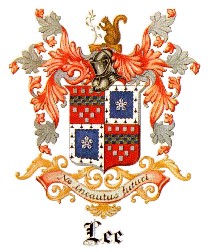|
|
|
|
||||||||||||||||
|
The Lee Coat of Arms, shown above, is the Coat of Arms of the Lees of Coton Hall in County Shropshire, England. A member of the Coton branch of the Lees of Shropshire, Colonel Richard Lee (also known as "Richard Lee the Immigrant") first came to Virginia circa. 1640, and he used the armorial bearings of the Lee family of Shropshire. The Latin Ne Incautus Futuri translates to the English "Not Heedless of the Future." |
||||||||||||||||
|
|
||||||||||||||||
|
||||||||||||||||
|
|
||||||||||||||||
|
BACKGROUND |
||||||||||||||||
|
A Coat of Arms is an emblem or a device which is displayed by titled persons, persons of royal blood, and their descendants. Coats of Arms were originally used for purposes of identification and recognition on the field of battle as well as in civil life. |
||||||||||||||||
|
It is claimed by some writers that Coats of Arms, in a crude form, were used by Noah's sons after the flood. There are records of other Coast of Arms, in one crude form or another, at different periods of ancient history. Heraldry, however, as we know it today, did not become of much importance until soon after the invasion of England by William the Conqueror, A. D. 1066. Heraldry became of general interest at about the time of the Crusades. |
||||||||||||||||
|
The Lee Coat of Arms shown above is the Arms of the Lees of Shropshire, created 1641. Coats of Arms very similar to it are used by the Lees of Langley, co. Salop (bart., extinct 1660), who were descended from Richard Lee, High Sheriff of Salop, 1479; the Lees of Coton, co. Salop; and many others. Numerous other branches of the Lee family have Coats of Arms resembling it. |
||||||||||||||||
|
This is the most widely used of all Lee Coats of Arms and has been in existence for many centuries. It is the arms of the Lee family of Virginia, and has been used for generations by their descendants and by many other American branches of the Lee family. It is quite appropriate that members of the Lee family who have a pride in their ancestry should display the family Coat of Arms, in proper colors. |
||||||||||||||||
|
This Coat of Arms is to be found in the Washington Memorial Chapel at Valley Forge, one of the most sacred spots in America. The first Choir Pew in the Chapel was the gift of the Society of the Lees in Virginia, and was formally presented by the Hon. Blair Lee on behalf of the Society, June 5, 1926, and dedicated in the presence of more than fifty members of this distinguished family. The memorial Choir Pew is of hand-carved oak, and on the Pew ends, Continental soldiers kneel in prayer. In the center of the Pew back are carved and colored the arms of the Lee family, with the date Anno Domini, 1641, and the motto, "Non Incautus Futuri." |
||||||||||||||||
|
|
||||||||||||||||
|
MORE... |
||||||||||||||||
|
In 1890, at the request of Leslie Lyle Campbell, Class of 1887, Professor W. G. Brown designed a white silk banner bearing the words “Washington and Lee University” embroidered in gold letters on a blue scroll. Below the scroll was a composite shield made up of elements of the coats of arms of the Washington family and the Lee family. The heraldic shield has survived the years, but the original banner has not. |
||||||||||||||||
|
Professor Brown apparently designed the full coat of arms with crest and motto before 1903. The crest, a raven rising out of a golden ducal coronet, comes from the Washington crest. The upper left quarter of the shield depicts an open book with an injunction from I Thessalonians to “test all things.” The three red mullets and two red bars on a silver field come directly from the Washington arms. The design in the lower left quarter is taken from the arms of Reginald de Le, a 13th century English sheriff, Robert E. Lee's ancestor. The cinquefoil and wavy-edged ermine border were added to the Lee arms after a marriage with the Astley family of Nordley, England. The motto non incautus futuri, a phrase from Horace's Satire 1 translated “not unmindful of the future,” also came from the Lee family arms. |
||||||||||||||||
|
The original phrase, haud ignara ac non incauta futuri, refers to the ant as 'neither unaware nor heedless of what will be.' The ant is feminine, hence the 'a' ending on incauta, which would not have done for a W&L motto in the 30's, so the ending was changed to the masculine 'us'. |
||||||||||||||||
